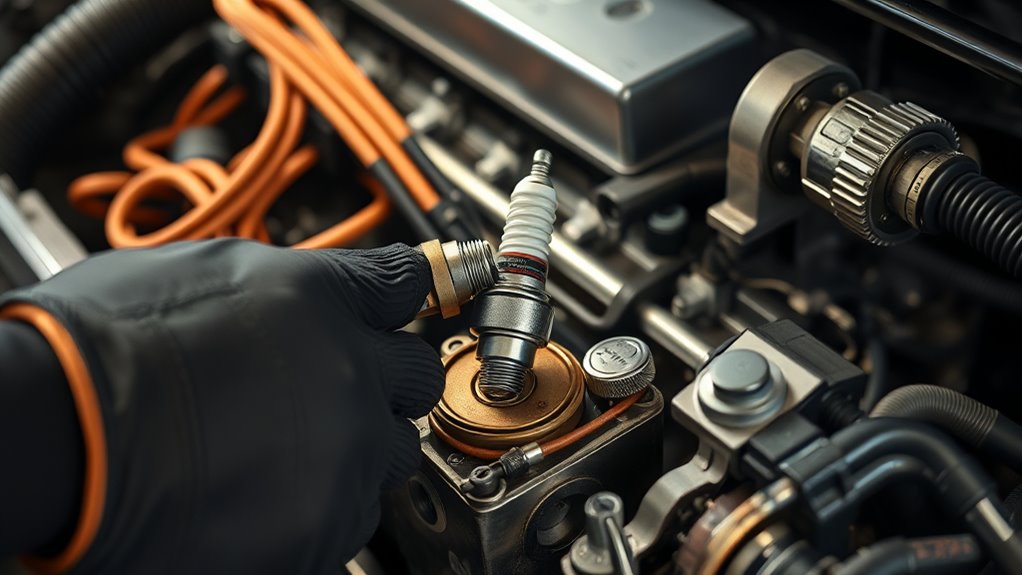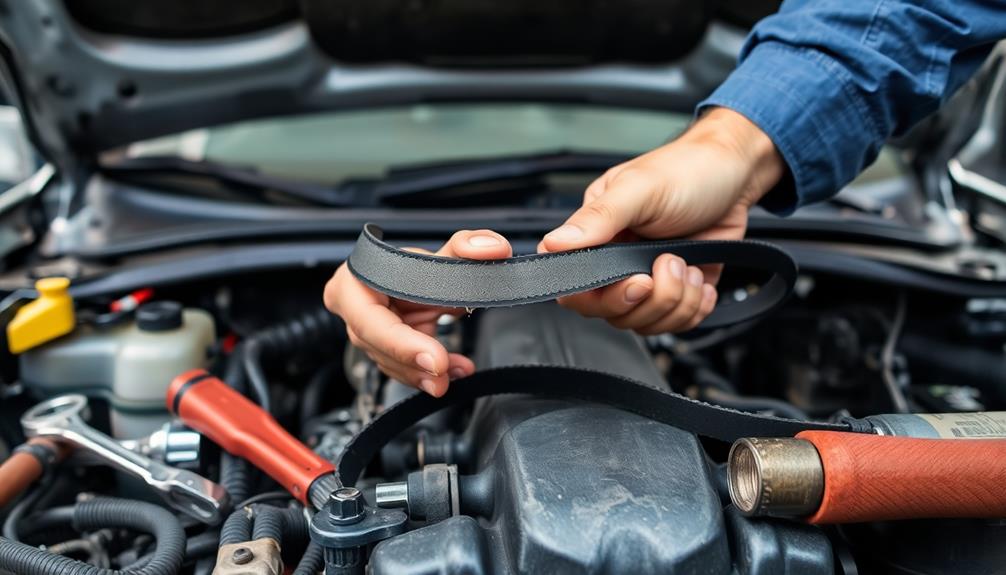Replacing your spark plugs and ignition coils is key to keeping your engine running smoothly and efficiently. You’ll need to identify the right parts for your vehicle, then disconnect and remove the old components. Installing new spark plugs and securing the coils properly guarantees strong, consistent sparks for better engine performance. Regular replacements prevent misfires and improve fuel economy. If you want to learn more about the step-by-step process, keep exploring the details below.
Key Takeaways
- Identify and select the correct spark plugs and ignition coils for your vehicle model.
- Locate components under the engine cover or along the cylinder head before removal.
- Disconnect electrical connectors, remove mounting bolts, and carefully extract old parts.
- Install new spark plugs using a torque wrench to meet manufacturer specifications.
- Reconnect electrical connections, secure coils, and test the engine for proper operation.

Ever wonder why your engine runs rough or struggles to start? Often, the culprit is worn-out spark plugs or failing ignition coils. These components are essential for igniting the fuel-air mixture in your engine’s cylinders. When they malfunction, your vehicle’s performance drops, and fuel efficiency suffers. Replacing spark plugs and coils isn’t just about fixing a rough idle; it’s about restoring ideal ignition timing and ensuring your engine runs smoothly and efficiently. Proper ignition timing is key to combustion, and if your spark plugs or coils are past their prime, this timing can become off, causing misfires and power loss. As a result, your engine has to work harder, burning more fuel and decreasing your miles per gallon. When you replace these parts, you’re effectively resetting the ignition system, which helps improve fuel efficiency and overall performance. Additionally, using high-quality replacement parts can further enhance engine reliability and longevity.
Worn spark plugs and coils disrupt ignition timing, causing poor engine performance and reduced fuel efficiency.
The process of replacing spark plugs and coils is straightforward but requires attention to detail. First, you’ll want to identify the correct parts for your vehicle. Not all spark plugs are the same, and coils vary depending on the make and model. Once you have the right replacements, you’ll need to locate the spark plugs and ignition coils, usually accessible under the engine cover or along the cylinder head. Disconnecting the coils involves removing electrical connectors and mounting bolts, then carefully pulling them out. Removing the spark plugs requires a spark plug socket and a ratchet. When installing new spark plugs, torque them to manufacturer specifications; over-tightening can damage the threads, while under-tightening might cause misfires. For coils, ensure they seat firmly and reconnect all wiring securely. Regular inspection of these components can prevent unexpected engine issues and maintain optimal performance.
Replacing these components can greatly improve your engine’s firing ability. Fresh spark plugs produce a strong, consistent spark, which helps maintain proper ignition timing. This ensures the fuel-air mixture ignites at the right moment, maximizing power and efficiency. Additionally, new ignition coils supply a more reliable spark, preventing misfires and rough idling. As a result, your engine runs more smoothly, accelerates better, and consumes less fuel. You may also notice a decrease in emissions because your engine burns cleaner with properly functioning spark plugs and coils. Proper maintenance of these parts aligns with leadership skills such as attention to detail and proactive problem-solving, which are essential for vehicle care.
Regular maintenance—checking and replacing spark plugs and coils as needed—keeps your engine performing at its best. Not only will this improve fuel efficiency, but it will also extend the lifespan of your engine and save you money on costly repairs down the line. When you keep these components in top shape, you’re ensuring your vehicle’s ignition system operates as it should, providing consistent starts, better power delivery, and ideal fuel economy every time you turn the key.
Frequently Asked Questions
How Often Should Spark Plugs and Coils Be Replaced?
You should replace your spark plugs and coils based on your vehicle’s maintenance schedule and manufacturer recommendations, typically every 30,000 to 50,000 miles. Regular inspections can help you catch signs of wear early. Keep an eye out for misfires, poor fuel economy, or difficulty starting. Following the recommended replacement intervals guarantees your engine runs smoothly and efficiently, preventing costly repairs down the road.
Can I Replace Spark Plugs and Coils Myself?
Ever wondered if you can tackle spark plug and coil replacement yourself? Yes, you can try DIY maintenance if you’re comfortable with basic tools and follow proper safety steps. However, if you’re unsure or want to guarantee everything’s done right, opting for professional service is wise. Do you want to risk damaging your engine or saving money? Ultimately, it’s about your confidence and experience level.
What Signs Indicate a Failing Spark Plug or Coil?
You’ll notice misfire symptoms or engine hesitation when your spark plugs or coils start failing. Your engine may run rough, especially during acceleration, or you might experience a loss of power. You could also see increased fuel consumption or difficulty starting your vehicle. If these signs appear, it’s a good idea to inspect your spark plugs and coils promptly, as ignoring them can lead to more serious engine problems down the line.
Are High-Performance Spark Plugs and Coils Worth the Cost?
Yes, high-performance spark plugs and coils can be worth the cost if you’re seeking superior performance gains. While they often come with a higher price comparison, they deliver better ignition, improved acceleration, and enhanced fuel efficiency. If you prioritize power and precision on the road or track, investing in these components makes sense. Otherwise, for everyday driving, standard parts usually suffice, saving you money without sacrificing reliability.
How Do I Choose the Right Spark Plug and Coil for My Vehicle?
You should choose spark plug types that match your vehicle’s specifications, considering factors like heat range and electrode design. Check your owner’s manual for recommended spark plug types and confirm coil compatibility with your ignition system. Opt for high-quality options if you want better performance, but always verify that the spark plugs and coils fit your vehicle’s make and model to avoid issues and ensure reliable operation.
Conclusion
Think of your engine as a finely tuned orchestra, with spark plugs and coils as the essential conductors. When they falter, the harmony breaks, and the music stalls. Replacing them restores the symphony’s rhythm, ensuring every note fires perfectly. By tending to these core elements, you’re not just fixing parts—you’re conducting a masterpiece of performance, keeping your vehicle’s melody smooth and vibrant for miles to come.









